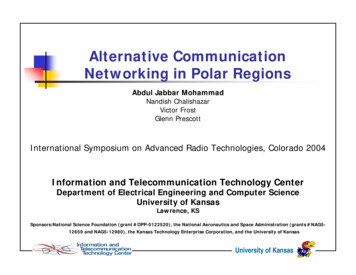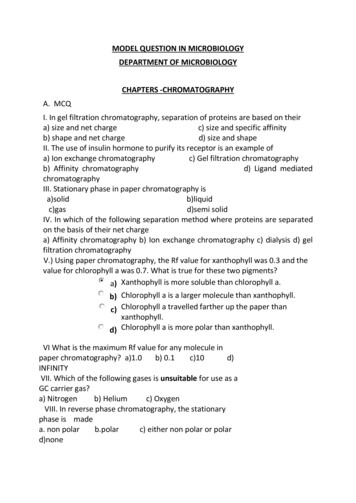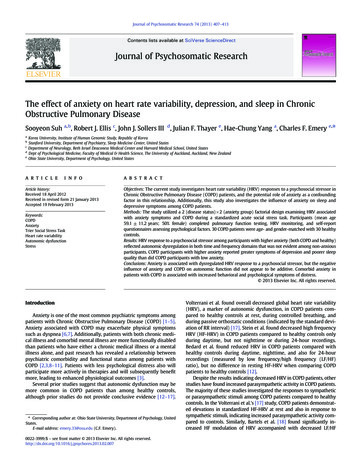
Transcription
Alternative CommunicationNetworking in Polar RegionsAbdul Jabbar MohammadNandish ChalishazarVictor FrostGlenn PrescottInternational Symposium on Advanced Radio Technologies, Colorado 2004Information and Telecommunication Technology CenterDepartment of Electrical Engineering and Computer ScienceUniversity of KansasLawrence, KSSponsors:National Science Foundation (grant #OPP-0122520), the National Aeronautics and Space Administration (grants #NAG512659 and NAG5-12980), the Kansas Technology Enterprise Corporation, and the University of KansasUniversity of Kansas
Presentation Outline Motivation Introduction Multi-Channel Iridium System Long range WI-FI System Field Experiments and Results Conclusions(work done by Nandish Chalishazar)University of Kansas2
Motivation Polar Radar for Ice Sheet Measurements (PRISM) :– developing intelligent remote sensingtechnology to determine thickness of ice sheets and ice-bedrock interface in Greenland and Antarctica.The system comprises of a sensor web deployed over intelligent rovers. Inter-rover communication Reliable, high bandwidth communications required between nodes separated by 8 Km on the iceData communication between the field camp and University of Kansas Data telemetry and access to University and web resources from field Public outreachGeneric data communication for Remote field research Mainstream communication system for polar science expeditions, field camps in Arctic/Antarcticand other research purposes Government and security useUniversity of Kansas3
Introduction – Satellite Communication Polar regions do not have conventionalcommunication facilities and are notserviced by most of the major broadbandsatellite systems (like Inmarsat, Intelsat,Globalstar). NASA satellites like ATS3, LES9, GOES,TDRS 1,and MARISAT2 provide access to Polar Regions Geo-synchronous,theyhavealimitedvisibility window at Poles – typically 10-13hrs/day. High satellite altitude and low elevationangles (1-20) result in extremely large fieldequipment. May not be readily available20 m diameter Marisat/GOES antenna at South PoleSource: http://cfa-www.harvard.edu/ aas/SPUC/02/presentations/SATCOM.pptUniversity of Kansas4
Introduction - Iridium Satellite System Iridium The only commercial satellite system with true pole-to-pole coverage 66 low earth orbiting (LEO) satellites Onboard satellite switching technology Minimum elevation angle of 8.20 Average satellite view time 9-10 minutes Access scheme is a combination of FDMA and TDMAProblem: Since it provides a low bandwidth of 2.4 Kbps, it is not practical to be usedas a main stream/ life-line communication system Solution: Inverse Multiplexing - Combine multiple satellite links using multi-link pointto point protocol (MLPPP) to obtain a single logical channel of aggregate bandwidthUniversity of Kansas5
Multi-channel Iridium System - DesignI. Modem 1I. Modem 2I. Modem 3I. Modem 4AntennaGridPPP clientUSB-SERIALRemoteSystemIridiumGatewayRemote SubsystemPPP ServerMulti-portPCI cardLocalSystemModemPoolPSTNLocal SubsystemUniversity of Kansas6
Multi-channel Iridium System – Protocol StackRemote SystemLocal SystemApplicationApplicationHTTP, FTP, SSHHTTP, FTP, SSHTCPTCPIPIPPPP/MLPPPPhysical Modemspoint-to-point satellite linksPPP/MLPPPPhysical ModemsUniversity of Kansas7
Multi-channel Iridium System – Network ArchitectureWorld Wide WebNGRIP Camp, Greenland100 MbpsEthernet(Default gateway)(Default gateway)Guser 4PPP ServerPPP ClientDefault Routereth0User 2100 MbpsEthernetppp0P-T-P Satellite linketh0ppp0User 1Guser 3User 3CampWI-FIGuser 2G user 1Local Network, University of KansasUniversity of Kansas8
WI-FI system Range of the commercial off-the-shelf systems is few hundred meters – not enough Increase the range of the 802.11b link up to 8 Km - amplification of the signal is required toovercome the propagation losses The two ray propagation model predicts forth power loss with distance over ice Also the received signal strength increases by 6 dB on doubling the height of the antenna Combination of high gain antenna and RF amplifier can help to achieve the required signalstrength 9-dBi vertical collinear antenna – horizontal beam width of 3600 and vertical beam width of 70. 1-Watt bidirectional amplifier with AGC and Tx of 29.3 dBmUniversity of Kansas9
WI-FI System Basic LAN Central Access point with high gain antennaand bidirectional amplifier End users use off-the-shelf 802.11b wirelesscards to access the Iridium based Internet Range 1 KmExtended LAN Both ends of the communication antennasneed amplifiers and high gain antennasconnected to the wireless cards Range 8 Km Bandwidth decreases with distanceUniversity of Kansas10
Field Experiments – Iridium System Fieldexperiments conducted at NGRIP, Greenland (75 06’ N, 42 20’ W) in Summer 20034-channel system setupAntenna SetupUniversity of Kansas11
Iridium Results – Delay and Loss Measurement Ping tests between the two machines at the end of the of satellite link Transmission Propagation delay 524msec Test results show an average RTT delay of 1.8 sec, Random delay variation and high mean deviation Causes may include - inter-satellite switching, processing at the gateway, distancebetween the user and satellite and distance between the satellites (ISL)RTT 0.809University of Kansas12
Iridium Results – Throughput Tools used – TTCP, IPERFThroughput Vs Number of ModemsThroughput varies to someextend due to RTT variation Efficiency 90%Effective throughputs during large file transfersFile Size (MB)Upload Throughput (Kbps) 6.884.252.1123Number of modemsUniversity of Kansas413
Time intervalbetween call y of :0021:15Number of 0323:2122:3921:5721:15Call drop eventIridium Results – Reliability: 24 hr testdropeventsvs. TimeCallCalldropson thefirst modemTotal :13 CalldropsTime4Modem up times during 24 hour testUptime %321080.691.894.796.8Time61814
Field Experiments – WI-FI SystemBase StationMobile VehicleUniversity of Kansas15
WI-FI system Results – Basic WLANVariation of SNR and throughput in basic (infrastructure) WLAN Infrastructure WirelessLANclients with in the campaccess the Iridium system Variation Internetof SNR with distancethroughput does not varywith SNRUniversity of Kansas16
WI-FI system Results – Extended LANVariation of RSS with distanceBase antenna height 3m and mobile antenna height 1.4m GPS error 10mVariation of RSS with distanceBase antenna height 3m and mobile antenna height 1.4m GPS error 10m Measurements are carried out using a fixed base station and a mobile client (peer-to-peer) Received signal strength variation matches very well with the theoretical two-ray propagation model The effects of using a multi-element antenna is accounted for in the theoretical predictionUniversity of Kansas17
WI-FI system Results – Extended LANVariation of signal to noise ratio along track 1 for equal antennaheights of 1.4, 2, 3 and 5 at the base station and mobile vehicleCorresponding TCP throughput measured every 0.5 Km Throughputvaries from 4.9 – 0.2 Mbps depending on the SNR Throughputdoes not decrease monotonically with packet errors inherent in a 802.11b link.University of Kansas18
Applications - Wireless Internet Data telemetry Wireless Internet/email access Download critical software on field ( up to7.2 MB) Obtain expert help while on the field Collaborate field experiments withmainland research facilities Public outreach – video clips, dailyreports, etc. General camp purpose: sending drawings to order spares for a broken caterpillar, excelspreadsheet for food order, general press releases downloading weather reports for planning C-130landingsUniversity of Kansas19
Conclusions Multi-channel Iridium communication could be used to reliable provide data and Internetaccess to Polar Regions. This system is easily scalable, lightweight, readily available and has round the clock, poleto-pole coverage. The developed link management software ensures fully autonomous and reliableoperation The Iridium system can be integrated with reliable long range 802.11b wireless to provideconnectivity for distances up to 8 Km The validity of two-ray propagation model over flat ice sheets in Polar Regions is proved The system provided for the first time, wireless data and Internet access to NGRIP campin Greenland.University of Kansas20
Questions ? Comments?THANK YOUjabbar@ittc.ku.eduUniversity of Kansas21
University of Kansas 5 Introduction - Iridium Satellite System Iridium The only commercial satellite system with true pole-to-pole coverage 66 low earth orbiting (LEO) satellites Onboard satellite switching technology Minimum elevation angle of 8.20 Average satellite view time 9-10 minutes Access scheme is a combination of FDMA and TDMA Problem: Since it provides a low bandwidth of 2.4 Kbps .











